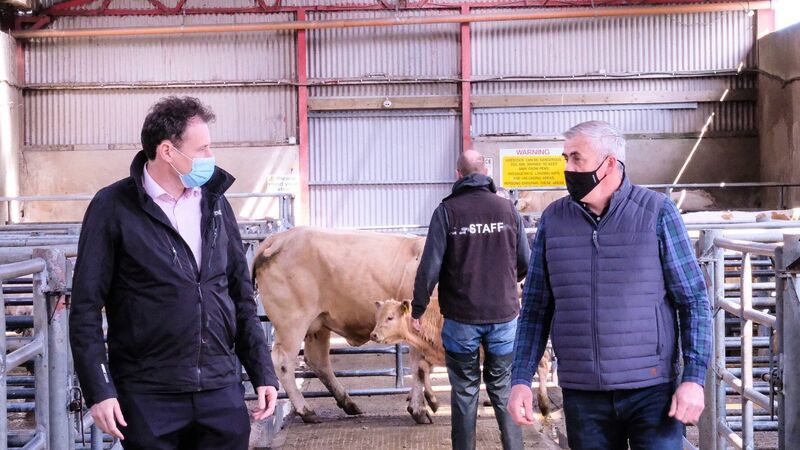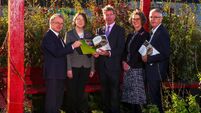Report states an absence of data has limited the independent examination of beef prices

Minister for Agriculture, Food and the Marine Charlie McConalogue on a recent visit to Carndonagh Mart with beef farmer Alan McLaughlin. The Minister said he hoped the work of the Beef Taskforce will be carried forward by the new Office of the National Food Ombudsman or regulator.
The value of beef animals for slaughter in Ireland between 2018 and 2019 was estimated at €2.1bn exclusive of VAT and the value of the sale of beef products from Ireland at €2.9bn in Grant Thornton’s independent examination of price composition.
Sales are €2.7bn excluding prepared or preserved products (which may be double-counted). The business services company said an absence of data limited their analysis in this report, which is one of three commissioned by the Department of Agriculture, Food and the Marine as part of the Beef Taskforce’s work.
The report said there is a high demand for Irish beef amongst customers across the globe, built up over time, and the quality and sustainability standards set in Ireland have supported in creating such a demand.
Most demand comes from near markets, which can purchase fresh or chilled Irish beef products. The UK market is the number one destination for Irish beef, followed by the domestic market. Demand from markets further away such as China and the Philippines tends to be for frozen product and hides.
Data available indicate a relatively even split in demand from retail (37%) and wholesale/foodservice (35%). Manufacturing accounts for 25% of the market demand for Irish beef, with the proportion of beef sold into commodity trading at just 2%.
Over the period examined Ireland slaughtered, on average, 1.86 million cattle per annum.
Animals purchased for slaughter are purchased inclusive of VAT, but beef products sold are subject to 0% VAT.
Grant Thornton said all Irish beef products in the period totalled 672,072 tonnes, at an average price per kilo across all markets of €4.35 a kilo. But data to determine the final value of Irish beef as paid by the consumer was not available.
Retail prices in certain markets are distorted, there is little or no reliable valuation of beef prices in the food services sector or in manufacturing.
Product sold into trading can be traded multiple times before it reaches the consumer.
“The absence of data on the final price paid for Irish beef by consumers globally makes it impossible to accurately allocate price points along the supply chain. The data presented accounts for only a proportion of the final supply chain for Irish beef.”
Grant Thornton said their report reflects a point in time in the complex beef supply chain, and market and customer volatility lead to changes in demand and pricing over time.
At last week’s Beef Taskforce meeting, Agriculture Minister Charlie McConalogue said: “I am pleased to see that the three market transparency studies commissioned by the Department are now completed. Notwithstanding the challenges identified in relation to data availability, these reports will act as an important starting point for further work on transparency. I hope that this work will be carried forward by the new Office of the National Food Ombudsman or regulator, to be established by primary legislation.” The Minister said the detailed actions set out in the Beef Sector Agreement are now completed or nearing completion, and he has asked for a detailed report on the work of the Beef Taskforce by its chairman, Michael Dowling.
Last week’s Taskforce meeting heard from Bord Bia that the mid-May farm gate prices of €4.13/kg Ireland versus €4.64 in the UK and the EU average of €3.82 flower gains in the Irish price in March, April, and May.
The Irish prime beef composite price has exceeded the prime export composite price since April 2021, and the prime EU composite since April 2020.
The Irish weekly cattle throughput so far in 2021 has been behind 2019, but has exceeded the 2020 supply since April.
UK beef production is forecast to fall by 5% in 2021, and by 2% in the EU-27.
According to Bord Bia, market challenges facing the Irish beef sector are concerns around environment, animal welfare, and antibiotics; local preference by consumers overseas; economic factors such as consumer spending and price sensitivity; more competition possible in the UK due to their new free trade agreements; implications of future EU food policies such as Farm to Fork; and “meat alternatives”.
Potential opportunities for the Irish beef sector are the increasing beef consumption and import demand in emerging markets; becoming the preferred choice of consumers choosing to eat “less but better” meat; maintaining shoppers’ positive impressions and associations of Irish beef; and recovery of foodservice demand.
South-East Asia is seen as an area of market opportunity because of its relatively low level of red meat consumption, rising incomes, and improved market access. Also, African Swine Fever has reduced pork consumption in Asia.
Bord Bia said international beef trading, in general, is currently strong. Although there has been reduced consumption of red meat in Western Europe, there has been no such drop in the US, and consumption increased over the last 12 months in China by 11%.
Meanwhile, Argentina’s president has called a 30-day halt to his country’s huge beef exports, in order to reduce the country’s domestic beef price.










